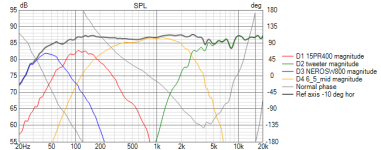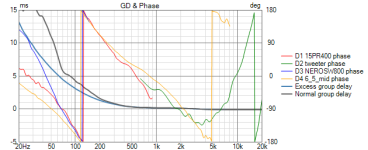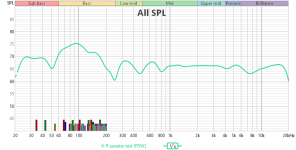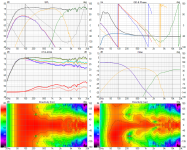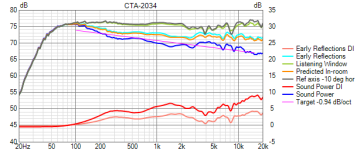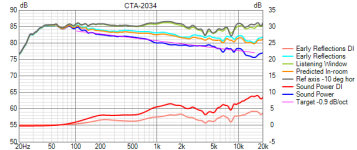Could you please elaborate on this further..? about which aspect were you pointing out specifically..It matches the freq response in your above post.
This in addition to your observation of group delay. ;-)
Sorry for the confusion.
The level variations, the broad dip 200-500 and 2 - 6 khz seem to match the blauerts bander. At minimum reducing the broad bump in between should already give a audible difference.
And regarding gd, our hearing appear to be sensitive to gd variations in lower frequencies. So a flat gd will sound better. It is also one of my other observation with my linear system.
The level variations, the broad dip 200-500 and 2 - 6 khz seem to match the blauerts bander. At minimum reducing the broad bump in between should already give a audible difference.
And regarding gd, our hearing appear to be sensitive to gd variations in lower frequencies. So a flat gd will sound better. It is also one of my other observation with my linear system.
Another thing I am curious nowadays about is the following.
I see a lot of people commenting about superiority in detail retrieval of one driver vs the other especially in different types of systems, for example a horn based system vs direct radiating system. For me recording and Playing back music played by my exar 400 horn based system and the SB 2way + dual woofer 4 way system was a revelation..
I thought the horn based system missed some fine details especially in treble that the 4 way system could play.. But upon hearing the recording I could hear that almost everything that the 4way system played was being played by the horn system also. It was just that I had not paid attention to those details in the horn based system.
So I wonder how much of all that details retrieval is the effect of directivity jumps and how much of it is our brain just not playing attention to those aspects..
I see a lot of people commenting about superiority in detail retrieval of one driver vs the other especially in different types of systems, for example a horn based system vs direct radiating system. For me recording and Playing back music played by my exar 400 horn based system and the SB 2way + dual woofer 4 way system was a revelation..
I thought the horn based system missed some fine details especially in treble that the 4 way system could play.. But upon hearing the recording I could hear that almost everything that the 4way system played was being played by the horn system also. It was just that I had not paid attention to those details in the horn based system.
So I wonder how much of all that details retrieval is the effect of directivity jumps and how much of it is our brain just not playing attention to those aspects..
Thanks @JanRSmit 🙂
I actually had 2 different presets for that crossover. One with a global PEQ applied to reduce that 600Hz to 2kHz bump to a flat-ish response on the axis, and the other preset without this EQ applied. I tried comparing both presets on the same set of few songs.. But I couldn't clearly hear any differences between them in the selected set of tracks I played.. That is why I didn't bother notching that broad 1dB bump later...
Anyway, the latest crossover that I am testing now is this one:

Excess group delay has reduced slightly now like shown below:
Earlier

Now

The bass impact is now noticeably/audibly better than earlier. I like it overall..
From an hour or so that I spent listening over a couple of days, I couldn't detect my earlier problem with LR2 (yet).
That is the "feeling of sound coming from different drivers". Now I also don't know if I had made some mistake earlier like inverting the polarity of the 15PR400 driver in the earlier set up which caused that impression.. Anyway, things are better now.. 🙂
But I doubt/am not sure if it has reached the same level as the Satori boxes. I would need to do a comparison between them to confirm..
Anyway, please also note that I have now taken "nitpicking" of faults to a whole new level. 😀
I am pretty sure anybody who gets to hear this system for the first time would be floored.. 😀
Also, here is the response of the system now from MLP with 4 cycle FDW

Compared to my earlier EXAR 400 based system, whose response is shown below, I like this one better "in a sense" as well 🙂

I actually had 2 different presets for that crossover. One with a global PEQ applied to reduce that 600Hz to 2kHz bump to a flat-ish response on the axis, and the other preset without this EQ applied. I tried comparing both presets on the same set of few songs.. But I couldn't clearly hear any differences between them in the selected set of tracks I played.. That is why I didn't bother notching that broad 1dB bump later...
Anyway, the latest crossover that I am testing now is this one:
Excess group delay has reduced slightly now like shown below:
Earlier
Now
The bass impact is now noticeably/audibly better than earlier. I like it overall..
From an hour or so that I spent listening over a couple of days, I couldn't detect my earlier problem with LR2 (yet).
That is the "feeling of sound coming from different drivers". Now I also don't know if I had made some mistake earlier like inverting the polarity of the 15PR400 driver in the earlier set up which caused that impression.. Anyway, things are better now.. 🙂
But I doubt/am not sure if it has reached the same level as the Satori boxes. I would need to do a comparison between them to confirm..
Anyway, please also note that I have now taken "nitpicking" of faults to a whole new level. 😀
I am pretty sure anybody who gets to hear this system for the first time would be floored.. 😀
Also, here is the response of the system now from MLP with 4 cycle FDW
Compared to my earlier EXAR 400 based system, whose response is shown below, I like this one better "in a sense" as well 🙂
Attachments
Last edited:
So many variables...
Listening is really important, sensitivity to different kind of measured imperfections varies and obviously the room has important role. So, when eg. Spl or DI step matches room reflection or RT peak, it will be heard easily.
Listening is really important, sensitivity to different kind of measured imperfections varies and obviously the room has important role. So, when eg. Spl or DI step matches room reflection or RT peak, it will be heard easily.
I have been listening to this latest mono speaker configuration for a while now..
To summarise my impressions averaged over this period of time, I am thoroughly impressed.
I am impressed enough to 3D print another speaker (2way top for the purifi-bliesma combo) so that I can hear how the whole system sounds like in a stereo configuration (and maybe rediscover things like image shift and other problems that come along with very wide dispersion speakers in a relatively not well-treated room 🙂 ). This is also because it will take a lot of time before I get any actual wooden cabinets built for this 2 way top due to other factors.
The star of the show is the Purifi driver which plays the range from around 150Hz to 2.8kHz. The Bliesma keeps up with it very comfortably as well.
Sometimes the vocals drums etc feel so scary real that one gets goosebumps and it is hard to come to terms with the fact that it is just an mp3 file or a YouTube video playing through the speakers.. 🙂
If just the 6.5-inch driver that I have reproduces the mids this well, I can't even imagine how the other Purifi drivers play the bass end of the spectrum. Probably, it has to be experienced to be believed, I guess.
For some newbie (/someone reading this thread for the first time), my recommendation for a really good speaker would be to save up money, make a 2/2.5-way using a Purifi-Bliesma/another good tweeter in a properly shaped cabinet (for controlling diffraction), implement a good crossover and be done if the purpose is to enjoy music. Reasons to build other speakers would be endless/purposeless tinkering with speakers for the fun of it.. (like me) 🙂
To summarise my impressions averaged over this period of time, I am thoroughly impressed.
I am impressed enough to 3D print another speaker (2way top for the purifi-bliesma combo) so that I can hear how the whole system sounds like in a stereo configuration (and maybe rediscover things like image shift and other problems that come along with very wide dispersion speakers in a relatively not well-treated room 🙂 ). This is also because it will take a lot of time before I get any actual wooden cabinets built for this 2 way top due to other factors.
The star of the show is the Purifi driver which plays the range from around 150Hz to 2.8kHz. The Bliesma keeps up with it very comfortably as well.
Sometimes the vocals drums etc feel so scary real that one gets goosebumps and it is hard to come to terms with the fact that it is just an mp3 file or a YouTube video playing through the speakers.. 🙂
If just the 6.5-inch driver that I have reproduces the mids this well, I can't even imagine how the other Purifi drivers play the bass end of the spectrum. Probably, it has to be experienced to be believed, I guess.
For some newbie (/someone reading this thread for the first time), my recommendation for a really good speaker would be to save up money, make a 2/2.5-way using a Purifi-Bliesma/another good tweeter in a properly shaped cabinet (for controlling diffraction), implement a good crossover and be done if the purpose is to enjoy music. Reasons to build other speakers would be endless/purposeless tinkering with speakers for the fun of it.. (like me) 🙂
Can you explain why you recommend 2.5 way vs a 3 or 4 way? When I look at your speaker I just assumed it was a 4 way but is it crossed so it works like a 2.5 way? Or is the the Satori boxes that were 2.5.
@CinnamonRolls: My current speakers are 4way/3.5way (since the 15PR400 woofer doesn't have a high pass applied on it. It rolls off naturally at the bottom based on the sealed alignment Q. The SB Nero Subwoofer driver has a low pass on it..
Regarding the reasons for my preference to 2 way 2.5way are the following:
1) I have learned that in general driver quality matters. We can penny pinch all we want and choose overall compromised drivers which may do very well for selected frequency ranges. But that compromise will force choices on other drivers and crossovers in hard to get right/accurate frequency ranges with at home measurements. So the simplest option in that point of view is to get a driver which can do very well everything below 1kHz or so, which the purifi does so very well. That makes measurements and crossover easier.
2) Good quality drivers like Purifi and bliesma/even the SB26ADC/CDC (which are what I have worked with) make the crossover easier especially for a passive crossover. A carefully shaped, sized (relatively shallow) cabinet with diffraction control (also directivity control) can make crossover even more easy. That helps with avoiding stacks of amps and wires running all around the place. Maybe a dsp plate amp like the hypex ones are also good in that aspect.
3) The recommendation for a 2way is to make life easy with building the cabinets and spending less money on the speaker itself. Relatively smaller cabinets, in my experience are easier to make and do it very well. But the compromise with a good driver like Purifi will be the overall sensitivity loss due to baffle step and response shaping. That is where I feel a 2.5way will help. The 2nd midwoofer will help gain that sensitivity back and help a bit in terms of max SPL capability and amplifier capabilities
4) Smaller speakers are easy to move around w.r.t positioning in room and one can try to get a good compromise regarding placement and reflection from boundaries.
5) Wide radiation pattern with good drivers is really very enjoyable to hear for longer durations of time if one has good enough room/a room that cooperates. One will be able to hear all the fine details in the music at even louder levels while not losing attention/trying to actively focus on any specific frequency range
6) It is easier to get timing and excess group delay at lower frequencies right with 2 way/2.5 way than 3/3+ way speakers..
I may be able to find more reasons but the above are convincing enough for me. 🙂
In summary, with good quality drivers in a 2way/2.5way will make it easier to build the speaker, measure accurately, easier to adjust position in room, find a relatively wide sweet spot/ "sweet sofa", enjoy all the benefits of one good amp and less clutter, all the time enjoying music and not thinking about what to build/upgrade next in terms of getting better sound quality 🙂
Regarding the reasons for my preference to 2 way 2.5way are the following:
1) I have learned that in general driver quality matters. We can penny pinch all we want and choose overall compromised drivers which may do very well for selected frequency ranges. But that compromise will force choices on other drivers and crossovers in hard to get right/accurate frequency ranges with at home measurements. So the simplest option in that point of view is to get a driver which can do very well everything below 1kHz or so, which the purifi does so very well. That makes measurements and crossover easier.
2) Good quality drivers like Purifi and bliesma/even the SB26ADC/CDC (which are what I have worked with) make the crossover easier especially for a passive crossover. A carefully shaped, sized (relatively shallow) cabinet with diffraction control (also directivity control) can make crossover even more easy. That helps with avoiding stacks of amps and wires running all around the place. Maybe a dsp plate amp like the hypex ones are also good in that aspect.
3) The recommendation for a 2way is to make life easy with building the cabinets and spending less money on the speaker itself. Relatively smaller cabinets, in my experience are easier to make and do it very well. But the compromise with a good driver like Purifi will be the overall sensitivity loss due to baffle step and response shaping. That is where I feel a 2.5way will help. The 2nd midwoofer will help gain that sensitivity back and help a bit in terms of max SPL capability and amplifier capabilities
4) Smaller speakers are easy to move around w.r.t positioning in room and one can try to get a good compromise regarding placement and reflection from boundaries.
5) Wide radiation pattern with good drivers is really very enjoyable to hear for longer durations of time if one has good enough room/a room that cooperates. One will be able to hear all the fine details in the music at even louder levels while not losing attention/trying to actively focus on any specific frequency range
6) It is easier to get timing and excess group delay at lower frequencies right with 2 way/2.5 way than 3/3+ way speakers..
I may be able to find more reasons but the above are convincing enough for me. 🙂
In summary, with good quality drivers in a 2way/2.5way will make it easier to build the speaker, measure accurately, easier to adjust position in room, find a relatively wide sweet spot/ "sweet sofa", enjoy all the benefits of one good amp and less clutter, all the time enjoying music and not thinking about what to build/upgrade next in terms of getting better sound quality 🙂
The small woofer size makes me think you're leaning toward a 2.5 way satellite rather than a full ranger that plays into sub-bass. Is that accurate?
@CinnamonRolls: I am talking about a relatively full range speaker for music, one that plays even low frequencies very well reasonably loudly.. 🙂
If my experience with the dual Satori boxes that I have been using earlier is anything to go by, I don't think one would need anything more than a dual purifi woofer system for even deep bass in a music listening application.
Obviously, I am not talking about a high SPL (especially in the bass) system for any home theatre application. It is there that I think multiple subs and a good horn based system would do well.. A well done horn based system may do well even in a studio monitor kind of application if one really needs to peer into the soul of a recording, pick things apart, and find out its faults and good things
But for really enjoyable casual listening purposes, even for hours at a time, I feel that a good 2way/2.5 as mentioned in above posts will be plenty enough..
If my experience with the dual Satori boxes that I have been using earlier is anything to go by, I don't think one would need anything more than a dual purifi woofer system for even deep bass in a music listening application.
Obviously, I am not talking about a high SPL (especially in the bass) system for any home theatre application. It is there that I think multiple subs and a good horn based system would do well.. A well done horn based system may do well even in a studio monitor kind of application if one really needs to peer into the soul of a recording, pick things apart, and find out its faults and good things
But for really enjoyable casual listening purposes, even for hours at a time, I feel that a good 2way/2.5 as mentioned in above posts will be plenty enough..
Last edited:
It was just that I had not paid attention to those details in the horn based system.
So I wonder how much of all that details retrieval is the effect of directivity jumps and how much of it is our brain just not playing attention to those aspects.
I did a comparison of a mic vs ear for another thread but will recycle...
.
Microphone (Mic)
- Generates more data than the human ear
- Can capture a wider range of frequencies and amplitudes
- Data generation is more complex, with a higher sampling rate and bit depth
- Approximately 8.5 MB of data generated for a 4-minute song
Human Ear
- Generates less data than a microphone
- Limited by tone simultaneous masking, can only process 2-4 tones simultaneously
- Data generation is less complex, with a lower effective sampling rate and bit depth
- Approximately 0.002-0.004 MB of data generated for a 4-minute song (a rough estimate)
You are right to suspect you are only listening to a few tones at one time. If you play an instrument you might hear more than the average person.
Headshake, where you got that info?
I haven't read many sources, but the one I have stated that ear as sensor is much more accurate than any instrument humans have built yet and sends astronomical amount of data as nerve firings, but rest of the auditory system then processes this info down and basically provides perception of it in the end.
I haven't read many sources, but the one I have stated that ear as sensor is much more accurate than any instrument humans have built yet and sends astronomical amount of data as nerve firings, but rest of the auditory system then processes this info down and basically provides perception of it in the end.
Sorry forgot to post reference, here is some snippets from the paoer and link to it. https://www.diyaudio.com/community/...ality-preference-or-skill.417471/post-7799669
An AI. I asked it to compare a mic with the ear. At first it told me the ear was more complex but once masking was introduced it is not.Headshake, where you got that info?
The eye has a foveal view ( a limited area of sharp focus). If I have someone touch my leg with one or two fingers near the same spot I can't tell the difference. On some level the ear hears every echo and the mind filters it out- "echo suppression mechanism". To hear is to selectively pick a sound out from the filtered noise. So there could be a trillion neurons but how we hear is selective.
One more 3way speaker configuration with the PureBliss top and dual Satori WO24Ps connected in parallel 🙂


In-room response from close to MLP with 4cycle FDW

Listening impressions-wise, it sounds pretty much very close to the 4-way system with PureBliss top and dual 15inchers, which is very nice.. 🙂
The subjective bass quality might be ever so slightly "tighter" than the latest iteration of 4way top and everything being a tiny bit clearer (possibly due to minor adjustments in the 2way top crossover resulting in that power response bump about 2k as well).. But at this point, I may also be imagining things.. 😀
One thing I could do is to get a better amp on the woofers. Even though the amplifier connected to the woofers is a 150W x 4ohm class AB amp, I have not heard anything better than the tiny Zoudio board-based two-way in terms of bass impact. This would also help me understand whether it is the excess group delay of 3way/4way or the amp that has been making me go around in circles searching for that impact of the bass on the body as I had before.
I keep making videos to remind me of how the sound changes between the speakers..
This comparison helps me a lot to understand my own preferences and how each system sounded in the room in certain frequency ranges.. 🙂
Here is a comparison of the same song recorded from same position for the 2 speakers (It is not volume matched, i leave it to the listener)
In-room response from close to MLP with 4cycle FDW
Listening impressions-wise, it sounds pretty much very close to the 4-way system with PureBliss top and dual 15inchers, which is very nice.. 🙂
The subjective bass quality might be ever so slightly "tighter" than the latest iteration of 4way top and everything being a tiny bit clearer (possibly due to minor adjustments in the 2way top crossover resulting in that power response bump about 2k as well).. But at this point, I may also be imagining things.. 😀
One thing I could do is to get a better amp on the woofers. Even though the amplifier connected to the woofers is a 150W x 4ohm class AB amp, I have not heard anything better than the tiny Zoudio board-based two-way in terms of bass impact. This would also help me understand whether it is the excess group delay of 3way/4way or the amp that has been making me go around in circles searching for that impact of the bass on the body as I had before.
I keep making videos to remind me of how the sound changes between the speakers..
This comparison helps me a lot to understand my own preferences and how each system sounded in the room in certain frequency ranges.. 🙂
Here is a comparison of the same song recorded from same position for the 2 speakers (It is not volume matched, i leave it to the listener)
Very interesting - the tonal character is quite different! 3-way much more "direct" and definitely brighter.Here is a comparison of the same song recorded from same position for the 2 speakers
Very impressive sound - would you tell us the name of the track for comparison to the original?
Yes.. The tonal character is definitely a bit on the brighter side.
This is because in this speaker crossover I purposefully changed the voicing a little bit by allowing a bit of power response hump compared to the earlier 4way speaker, trying to flatten the on axis response and listening window responses and not doing anything to remove the resulting power response hump. 🙂
Current 3way

compared to earlier 4way shown below

The above changes can be undone, but at the moment, on most of the tracks I listen to, I like this 'brightness' a bit more than the earlier speaker.
Also noticeable is the slight change in bass character; it has changed from slightly 'softer in the 4way to a 'harder-hitting version on the 4way.
I feel that Satori woofers themselves have an overall 'brighter'/livelier sound in general compared to the woofers in the 4way system. Part of this can even be due to the directivity differences I guess. another part due to the sealed alignment differences, cabinet damping differences, woofer cone differences etc?
Depending upon the headphone used for playback, there might be an exaggerated sense of sibilance, which I can assure is not noticeable in real life, while playing the speakers. My Truthear crinnacle zero has this exaggerated sibilance. 🙂
The original track is this:
This is because in this speaker crossover I purposefully changed the voicing a little bit by allowing a bit of power response hump compared to the earlier 4way speaker, trying to flatten the on axis response and listening window responses and not doing anything to remove the resulting power response hump. 🙂
Current 3way
compared to earlier 4way shown below
The above changes can be undone, but at the moment, on most of the tracks I listen to, I like this 'brightness' a bit more than the earlier speaker.
Also noticeable is the slight change in bass character; it has changed from slightly 'softer in the 4way to a 'harder-hitting version on the 4way.
I feel that Satori woofers themselves have an overall 'brighter'/livelier sound in general compared to the woofers in the 4way system. Part of this can even be due to the directivity differences I guess. another part due to the sealed alignment differences, cabinet damping differences, woofer cone differences etc?
Depending upon the headphone used for playback, there might be an exaggerated sense of sibilance, which I can assure is not noticeable in real life, while playing the speakers. My Truthear crinnacle zero has this exaggerated sibilance. 🙂
The original track is this:
Attachments
Last edited:
Vineeth,
Will you share mlp measurement?
We have similar listening space so would like to compare with mine.
Thank's
Will you share mlp measurement?
We have similar listening space so would like to compare with mine.
Thank's
I haven't watched any of your videos to know what tracks you were playing, but here is some more Psy-Trance I quite like, the kick bass is fun for testingThe original track is this:
- Home
- Loudspeakers
- Multi-Way
- A 3 way design study
